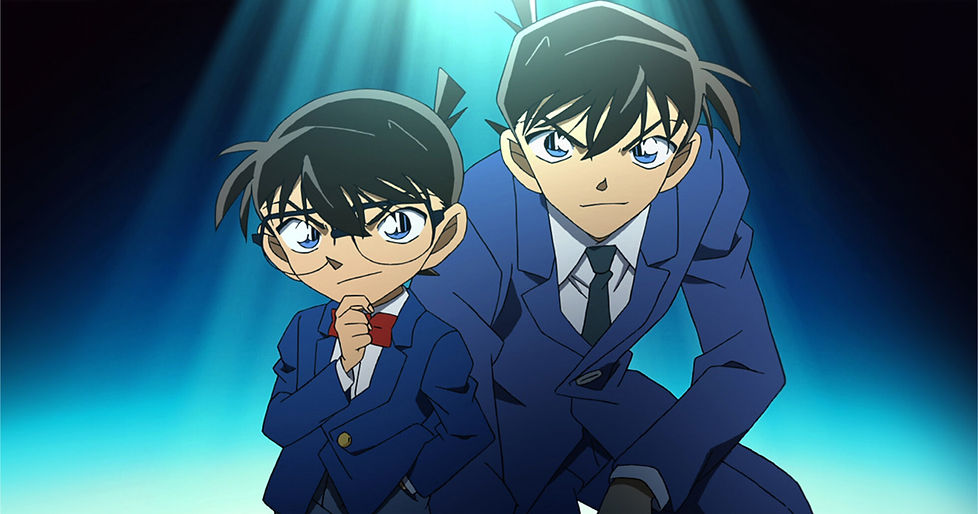
"Beyond The Page"
Between Panels and Frames:
Growing Up with Detective Conan

I still remember the first time I stumbled upon Detective Conan. It wasn’t love at first sight - just curiosity. The cover looked like a typical shōnen mystery, the kind I’d read on lazy summer afternoons. But by the time I reached the third or fourth case, I was no longer reading just for the puzzles. I was reading for that quiet sadness behind every solved mystery - the kind of melancholy that lingers long after the culprit confesses.
Gosho Aoyama’s world has always been more than a playground for logic. Beneath the codes, gadgets, and blood trails, Detective Conan is a meditation on loneliness and the fragile nature of truth. Every case begins with death, but it ends with revelation - not only of what happened, but of what people hide, what they fear, what they love. There’s something deeply human about that: the idea that truth, no matter how painful, is worth uncovering.
When the anime came along, it turned that quiet world into something vivid, almost cinematic. Suddenly, the ticking clocks, the rain-soaked streets, and the neon-lit nights of Tokyo had sound, rhythm, and color. Yet somehow, that brilliance came with a trade-off. The manga had always felt intimate - the kind of silence between panels that invites the reader to fill in the air themselves: the sound of a breath held, the soft thud of a dropped clue, the long pause between realization and grief.
The anime, by contrast, fills every space with movement. It paints over silence with music - that instantly recognizable suspense theme, the violin-heavy nostalgia of endings, the sound of truth unfolding in real time. It’s dazzling, yes. But sometimes, I miss the stillness. In manga, I could linger on Conan’s expression, on Ran’s half-smile, on the flicker of guilt in a suspect’s eyes. In the anime, the moment passes before I can catch it.
Still, I wouldn’t call one better than the other. The two are simply different lenses - one internal, one external. The manga feels like reading someone’s private thoughts: methodical, deliberate, precise. The anime feels like watching a heartbeat - dynamic, emotional, unpredictable. When I read the manga, I’m inside Conan’s mind: dissecting clues, questioning motives, searching for logic amid chaos. When I watch the anime, I step back into the world - a world that laughs, cries, and moves even when no one is solving anything.
Over time, I realized Detective Conan isn’t really about crime at all. It’s about what people do when they’re desperate for truth - or running away from it. Some kill to hide love; some lie to protect pride; some simply break under the weight of their own secrets. And in the middle of it all stands Conan - a boy frozen between childhood and adulthood, carrying the wisdom of one and the loneliness of the other.
There’s something almost tragic about his existence: brilliant yet helpless, courageous yet perpetually small. And maybe that’s why the story still feels timeless. Conan doesn’t age because the search for truth never does.
What fascinates me most, though, is how Detective Conan grows with its audience. When I was younger, it was all about deduction - who did it, how, and why. But as I got older, I started noticing the small things: the tenderness between Kogoro and Eri, the quiet sadness of Haibara, the unspoken tension between Conan and Ran. These aren’t just side plots anymore; they’re the emotional threads that hold the entire story together.
There’s also something profoundly Japanese about the way the series handles morality - not in absolutes, but in shades. Even the “villains” often have reasons rooted in grief, regret, or love. The cases aren’t just puzzles; they’re portraits of human frailty. Aoyama doesn’t judge his characters - he lets them reveal themselves. And maybe that’s why, even after hundreds of episodes and volumes, the stories still resonate: because truth, in this world, is never black or white. It’s painfully, beautifully gray.
Whenever I revisit Detective Conan, I don’t do it for nostalgia. I do it because it reminds me of something simple yet profound - that intelligence can uncover lies, but only courage can face the truth. There’s a line between knowing and accepting, and Conan has been walking that line for decades, never quite reaching the end.
Sometimes I think that’s why the story never truly ends. It’s not about catching the final culprit or reversing a curse. It’s about that quiet persistence - the need to keep looking, even when the truth hurts.
And perhaps that’s what makes Detective Conan more than just a detective story. It’s a coming-of-age tale disguised as a mystery - one where the biggest revelation isn’t who the killer is, but who we become when we dare to see the world as it truly is.
Some mysteries can be solved with reason. Others must be lived through - one clue, one heartbreak, one truth at a time.